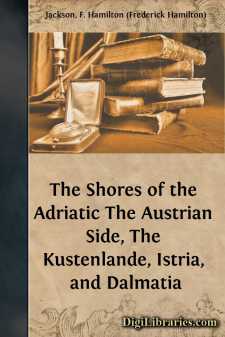Categories
- Antiques & Collectibles 13
- Architecture 36
- Art 48
- Bibles 22
- Biography & Autobiography 813
- Body, Mind & Spirit 142
- Business & Economics 28
- Children's Books 17
- Children's Fiction 14
- Computers 4
- Cooking 94
- Crafts & Hobbies 4
- Drama 346
- Education 46
- Family & Relationships 57
- Fiction 11829
- Games 19
- Gardening 17
- Health & Fitness 34
- History 1377
- House & Home 1
- Humor 147
- Juvenile Fiction 1873
- Juvenile Nonfiction 202
- Language Arts & Disciplines 88
- Law 16
- Literary Collections 686
- Literary Criticism 179
- Mathematics 13
- Medical 41
- Music 40
- Nature 179
- Non-Classifiable 1768
- Performing Arts 7
- Periodicals 1453
- Philosophy 64
- Photography 2
- Poetry 896
- Political Science 203
- Psychology 42
- Reference 154
- Religion 513
- Science 126
- Self-Help 84
- Social Science 81
- Sports & Recreation 34
- Study Aids 3
- Technology & Engineering 59
- Transportation 23
- Travel 463
- True Crime 29
The Shores of the Adriatic The Austrian Side, The Kustenlande, Istria, and Dalmatia
Description:
Excerpt
PREFACE
This volume is complementary to that dealing with the Italian side of the Adriatic, and follows much the same lines. It has not been thought necessary to repeat what appeared there about the sea itself, but some further details on the subject have been added in an introductory chapter. The concluding chapter treats of the influence which the two coasts exerted on each other, and contains some hints as to certain archæological problems of great interest, which deserve fuller and more individual treatment than they can receive in such a work as the present.
In a country which still contains so much that is unfamiliar, so many mediæval survivals in customs and costume, and so much that is fine in scenery, architecture, and the decorative arts, the picturesque aspect of the country has been dwelt upon more than was the case in dealing with the Italian side, and the meticulous description of buildings has to a great extent been abandoned, except in cases where it was necessary for the full understanding of the deductions drawn from existing details. At the same time, matters of archæology have not been neglected, and the rich remains of mediæval goldsmiths' work have received special attention. The costume, the customs, and the folk-lore of the Morlacchi are also treated of in considerable detail.
The determination of the Croat majority to stamp out the Italian language by insisting upon instruction in the schools being given solely in Croat will, in the course of a generation, make Italian a foreign language understood by few; and it seems wise for those who desire to visit Dalmatia to do so soon, while it is still understood and before Italian culture is forgotten.
The present work does not pretend to in any way rival Mr. T.G. Jackson's classic volumes on the architecture of the country, in completeness of historical treatment or architectural detail. Though Sir Gardner Wilkinson had published a book on the country, and the brothers Adam's full description of Diocletian's Palace was well known to connoisseurs, he may be said to have practically discovered Dalmatia for the Englishman; and it is a proof of the excellence of his work that, though twenty years have elapsed since it was published, it has never been surpassed, and its value remains undiminished. To these volumes the author desires to acknowledge his indebtedness, as well as to the "Mittheilungen" of the Austrian Central Commission for the Conservation of Historical Monuments; the "Bullettino di Storia Dalmata," conducted by Mgr. BuliÃâ¡ at Spalato; the "Atti" of the Istrian "Società di Archeologia e Storia Patria," published at Parenzo; and the "Archeografo Triestino," published at Trieste, all chronicling discoveries as they were made, and containing articles giving interesting and reliable information upon the history and antiquities of the coast. In addition, the following works have been consulted:
Freeman's "Subject Lands of Venice"; Munro's "Rambles and Studies in Bosnia and Herzegovina"; Neale's "Travels in Dalmatia"; Villari's "Ragusa"; Benussi's "L'Istria"; Bianchi's "Zara Cristiana" and "Antichità Romane e mediævale di Zara"; Mgr. BuliÃâ¡'s "Guide to Spalato and Salona"; Caprin's "Il Trecento a Trieste," "Alpi Gulie," and "L'Istria noblissima"; Carrara's "La Dalmazia descritta"; Chiudina's "Le Castella di Spalato"; Fabianich's "La Dalmazia nè primi cinque secoli del Cristianesimo"; Fosco's "La Cathedrale di Sebenico"; Franceschi's "L'Istria"; Gelcich's "Memorie storiche delle Bocche di Cattaro" and "Dello Sviluppo civile di Ragusa"; Lago's "Memorie sulla Dalmazia"; Lucio's "History of Dalmatia and Traù"; Ludwig and Molmenti's "Vittore Carpaccio"; Mantegazza's "L'Altra Sponda"; Modrich's "La Dalmazia"; Pasini's "Il Tesoro di S. Marco in Venezia"; Cav. G.B. di Rossi's "La Capsella Argentea africana," &c., and the two series of "Bullettino di Archeologia Cristiana"; Sabalich's "Guida Archeologica di Zaza"; Tamaro's "Le Citta dell' Istria"; and volumes of the Zara "Annuario Dalmatico"; Bamberger's "Blaues Meer und Schwarze Berge"; Danilo's "Dalmatien"; "Die Monarchic in Wort und Bild"; Eitelberger von Edelberg's "Gesammelte Kunsthistorischen Schriften"; Hauser's "Spalato und die monumente Dalmatiens"; Heider's "Mittelaltliche Kunst denkmale des Œsterreichischen Kaiserstaates"; Passarge's "Dalmatien und Montenegro"; Petermann's "Führer durch Dalmatien"; Tomasin's "Die Volkstamme im Gebiete von Triest und in Istrien"; Von Warsberg's "Dalmatien"; and Count Lanckoronski's magnificent monograph of the Cathedral of Aquileia....



